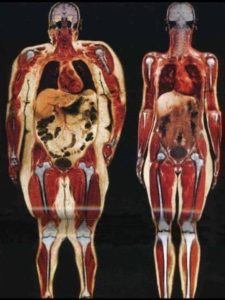Not all Fat is Equal
Everyday we are bombarded with advertisements for weight loss. When we go to the doctor we’re weighed which tells us what our current relationship with gravity is, but not much else. People think that looking “skinny” and being fit is the same thing. We don’t know what we’re composed of, unless we take the time to get a body composition analysis done.
We’ve done a couple of different kinds; using a scale with an impedance measurement and the water tank. Both have their problems, the scale is not the most precise, it’s accurate in the relationship but not precise in the percentages. We can get a less precise reading if we wear socks, or if we’re dehydrated… But from test to test it’s the level of accuracy. The water tank is supposedly more precise, but I’m not convinced that it’s better for the cost.
Either way we are often in for a shock when we compare our body composition to our weight. If you weigh 200lbs. with 15% body fat and 30% muscle you’re doing pretty good. On the other hand, if you weigh 200lbs. with 30% body fat and 15% muscle, you’re in trouble.
We carry our fat either under the skin (Cutaneous Fat) or around our organs (Visceral Fat). Visceral fat is the deadly one. A person may look skinny and still be fat. We call this skinny fat. In fact. one of the participants in a Nutrition Challenge we did was the least visibly fat but had the most body fat. Since it wasn’t visible it may have been around the organs.

Notice the difference between the Visceral and Cutaneous Fat.
Our composition is made up from: Fat, Muscle, Bone, Organs and water. The easy weigh to lose weight is to sweat. You’ll regain it as soon as you re-hydrate. This is the trick athlete’s who compete in weight class events use. Losing bone, muscle or organs is not a very smart strategy. In fact the loss of muscle can increase the fat you gain overtime.
When you see someone who is skinny, check their muscle composition. Can you see any obvious muscle? Is this the person you want to come rescue you from a burning building?
The fat that is carried around the organs is there to protect them from shock. When this fat deposit becomes too large it can inhibit the organ function. Organs have a normal movement they carry out, motility. If the fat prevents this movement the organ will not perform correctly. This lack of motility may be what causes the organs of an obese person to perform poorly or even fail. Once the fat is reduced, not the weight, the organs often come back to normal function. This may also be the result of a better diet, one that leads to fat reduction.
I wish there were a way to look at a body and tell how much fat it is carrying, and where, but there isn’t. But rather than getting on the scale every week to see how much you weigh, you may want to break out the tape measure and see how much your shape is changing. How much are your muscles toning? Do you feel stronger? More muscle leads to denser bone, and more calories being burned.

Recent Comments